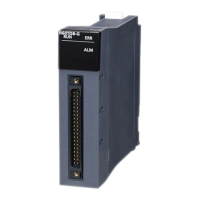126
9 LABEL ACCESS
9.1 Data to be Specified in Commands
Label name
Specify the character string of a label name.
■Data communication in ASCII code
Convert the numerical value of UTF-16, which indicates a global label name, to ASCII code (hexadecimal), and send it from
the upper digits.
■Data communication in binary code
Send the numerical value of UTF-16, which indicates a global label name from lower byte (L: bit 0 to 7).
When 'A'
(UTF-16: 'A'= 0041)
Labels of the simple data type
Specify the label name as it is.
Bit specification (example: Lbl.3) and digit specification (example: K4Lbl) cannot be used.
When the label name is 'Lbl'
Array type label
Specify the element number with square brackets '[ ]' after label name. (UTF-16F: '[' = 005B, ']' = 005D)
The element name of array cannot be specified in the square bracket. Specify a numerical value of the element number.
When the element number of array name 'Lbl' is '20'
• Label name length: 7H
• Label name character string: Lbl[20]
■Decimal/hexadecimal notation of element numbers
An element number can be specified in decimal or hexadecimal.
The element numbers can be distinguished by attaching 'k' or 'h' in front of the numerical value. (UTF-16: 'k'= 006B, 'h= 0068)
When only numerical value is specified, it will be handled as a decimal number.
• Decimal: Numerical value only, or attach 'k' in front of the numerical value. (Example: Lbl[10], Lbl[k10])
• Hexadecimal: Attach 'h' in front of the numerical value. (Example: Lbl[h10])
ASCII code Binary code
Item Value of code corresponds to
character
File name L b l
UTF-16 004C 0062 006C
ASCII code 30303443 30303632 30303643
Binary code 4C00 6200 6C00
Item Value of code corresponds to character
File name L b l [ 2 0 ]
UTF-16 004C 0062 006C 005B 0032 0030 005D
ASCII code 30303443 30303632 30303643 30303542 30303332 30303330 30303544
Binary code 4C00 6200 6C00 5B00 3200 3000 5D00
41
H
00
H

